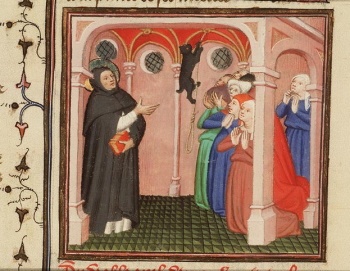I’m a dog person. Always have been. So much so that my kids have as many dogs as there were humans in our nuclear family. Cats are another matter. Never liked them. Never trusted them. Now I come to find out maybe it’s in my (extremely lapsed) Catholic genes.
Chasing heretics was a favorite Catholic pastime in the Middle Ages. In the early 13th Century the church was determined to stamp out the Cathari and other dualist sects. They believed there were two principles, one good and the other evil, and that the material world is evil. In fact, this was the beginning of the Inquisition.
In October 1231, Pope Gregory IX appointed Konrad of Marburg as Germany’s first papal inquisitor. Konrad took to his job with so much gusto that even a Catholic encyclopedia says he “proved too severe and harsh.” In fact, in 1233 the Archbishop of Mainz wrote Pope Gregory, saying, “Whoever fell into [Konrad’s] hands had only the choice between a ready confession for the sake of saving his life and a denial, whereupon he was speedily burnt.”
Konrad reported to the Pope that he had uncovered a satanic cult that worshiped devils in the forms of a demonic man and a diabolical black cat. In response, on June 13, 1233, Pope Gregory sent Konrad, the Archbishop of Mainz and the Bishop of Hildesheim, a “Proclamation on the Word of God” (i.e., a papal bull). Although translations vary slightly, Gregory described the cult’s initiation ritual, including the following:
Afterwards, they sit down to a meal and when they have arisen from it, the certain statue, which is usual in a sect of this kind, a black cat descends backwards, with its tail erect. First the novice, next the master, then each one of the order who are worthy and perfect, kiss the cat on its buttocks. Then each [returns] to his place and, speaking certain responses, they incline their heads toward the cat. “Forgive us!” says the master, and the one next to him repeats this, a third responding [says], “We know, master!” A fourth says: “And we must obey.”
When this has been done, they [put] out the candles, and turn to the practice of the most disgusting lechery.

The Devil Appears to St. Dominic
Many assert that Pope Gregory’s association of black cats with satanic cults is why they’re considered unlucky and witch familiars. Although the bull urges vigorous repression of the alleged cults, it says nothing about destroying cats as part of the process. Still, there are claims it prompted widespread cat killing throughout the Middle Ages. Others say this purported massacre made it easier for the Black Plague to spread because fleas on rats were the source of the disease. That theory is relatively easily debunked.
While black cats got a bad rap from a world leader, things also didn’t turn out so well Konrad. After he accused a German count of indulging in satanic orgies, the Archbishop of Mainz convened an assembly of bishops and princes on July 25, 1233. They declared the count innocent. On July 30, Konrad was returning to Marburg when he was attacked and killed by several knights. Locals reportedly have long believed the place where he was killed is haunted.
No word on whether black cats congregate there or were complicit in Konrad’s murder.
Furthermore, these most miserable of men blaspheme against the Lord of Heaven and in their madness say that the Lord has done evil in casting out Lucifer into the bottomless pit.
Pope Gregory IX, Vox in Rama







